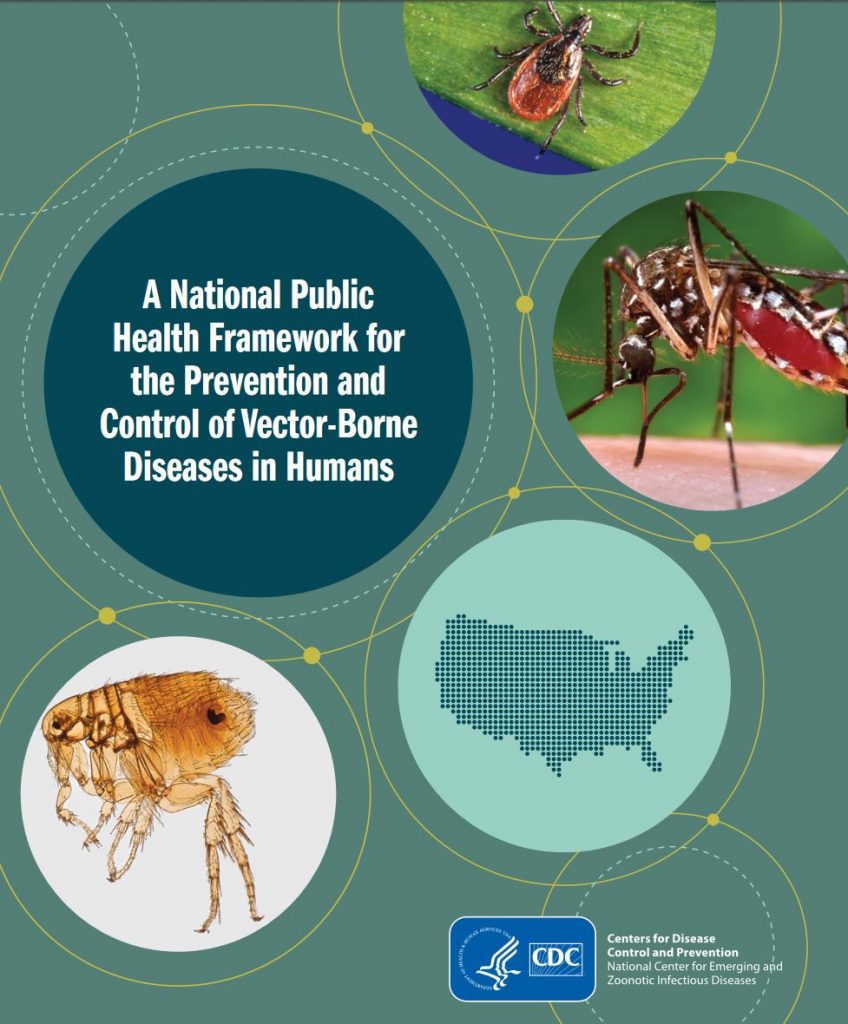LYME SCI: Feds adopt “national strategy” for vector-borne diseases

The Kay Hagan Tick Act, passed in 2019, called for the US Department of Health and Human Services (HHS) to develop a national strategy to address issues related to vector-borne diseases.
The idea was for HHS to co-ordinate with other federal agencies and departments, including the EPA, the Department of Defense, and others, to get everybody working towards the same goals.
In an encouraging development, CDC representative Ben Beard made an important announcement about that at Sept. 22’s Tick-Borne Disease Working Group meeting.
It’s called “A National Public Health Framework for the Prevention and Control of Vector-Borne Diseases in Humans.” The cover of the new plan represents ticks, mosquitoes, and fleas–all vectors that pose public health risks.
The following is taken from the CDC website.
The Framework
The National Strategy shall include objectives, activities, performance metrics, as well as a coordination and monitoring plan.
The Vision
A nation where vector-borne diseases no longer threaten human health and well-being
The Purpose
Protect people from illness, suffering, and death due to vector- borne diseases.
The Goals
- Better understand when, where, and how people are exposed to and get sick or die from vector-borne diseases
- Develop, evaluate, and improve tools and guidance for the diagnosis and detection of vector-borne diseases
- Develop, evaluate, and improve tools and guidance for the prevention and control of vector-borne diseases
- Develop and assess drugs and treatment strategies for vector-borne diseases
- Disseminate and support the implementation of effective public health and vector control products, tools, and programs to prevent, detect, diagnose, and respond to vector-borne disease threats
Working Together
The National Framework details the strategic priorities of the federal government that will lay a framework for critical vector-borne disease prevention and control activities. However, the federal government cannot address the complex challenges presented by vector-borne diseases alone.
To successfully prevent and control vector-borne diseases in humans, a multidisciplinary set of stakeholders must be engaged, activated, and resourced. The stakeholders include the federal government; state, tribal, local, and territorial health departments; vector control agencies; healthcare providers; academic and industry partners; policy and decision-makers, including Congress and elected community leaders; public health partners, such as nonprofit organizations and associations of medical, entomological, and vector control professionals; and the public, including patients.
Kay Hagan TICK Act
This new National Strategy was authorized by the Kay Hagan TICK Act of 2019 with oversight and coordination delegated to the Office of the Secretary in DHHS.
The TICK Act specifies:
- Require the Department of Health and Human Services (HHS) to develop a National Strategy. This would help expand research, improve testing and treatment, and coordinate common efforts across federal agencies including with DOD, USDA, EPA, the VA, and the Departments of Interior and Homeland Security.
- Reauthorize Regional Centers of Excellence in Vector-Borne Disease for five years at $10 million per year. Funding for these centers, which was allotted in 2017, expires in 2021. These Centers have led the scientific response against tick-borne diseases, which now make up 75 percent of vector-borne diseases in the U.S. There are five centers located at universities in New York, California, Florida, Texas, and Wisconsin.
- Authorize CDC grants at $20 million per year that would be awarded to state health departments to improve data collection and analysis, support early detection and diagnosis, improve treatment, and raise awareness. These awards would help states build a public health infrastructure for Lyme and other tick and vector-borne diseases and amplify their initiatives through public-private partnerships.
Progress
At the end of the TBDWG meeting, Beard went out of his way to personally thank patient representative Pat Smith and other members of the TBDWG for their contributions. So, it appears the goals of the National Strategy are similar to many goals of the TBDWG.
I sat on the TBDWG sub-committee that worked hard to develop a nationwide tick control plan, something the U.S. has never had before. So, I’m particularly excited to see our concerns reflected in the new framework.
This was the 15th meeting of the TBDWG that I have live-tweeted since the panel began in 2017. In addition to meetings of the entire Working Group, each of the individual sub-committees have met separately over the years, representing countless hours for the members and staff of the TBDWG.
It’s gratifying to see the federal agencies coming together and recognizing the importance of tick-borne diseases and the TBDWG. Let’s hope the progress continues.
LymeSci is written by Lonnie Marcum, a Licensed Physical Therapist and mother of a daughter with Lyme. In 2019-2020, she served on a subcommittee of the federal Tick-Borne Disease Working Group. Follow her on Twitter: @LonnieRhea Email her at: lmarcum@lymedisease.org .
Resources:
Link to the full 16 page framework here: https://www.cdc.gov/ncezid/dvbd/pdf/Brochure_National_Framework_VBDs-P.pdf
Link to the two page fact sheet here: https://www.cdc.gov/ncezid/dvbd/pdf/FS_National_Framework_VBDs-P.pdf
Link to 2018 TBDWG Report to Congress: https://www.hhs.gov/sites/default/files/tbdwg-report-to-congress-2018.pdf
Link to 2020 TBDWG Sub-Committee Reports: https://www.hhs.gov/ash/advisory-committees/tickbornedisease/reports/index.html




















We invite you to comment on our Facebook page.
Visit LymeDisease.org Facebook Page